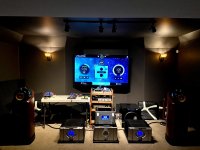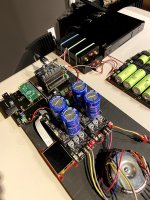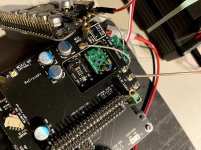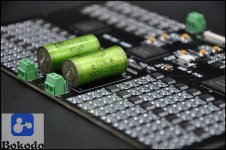My idea is to use Raspberry 4 + DAM1121(R2R DAC) using I2S. DAM1121 has own reclocker but it is not pure reclocking according to some members. Do I need FifoPi Q3 or simple take I2S from 40 pin GPIO.
@Tesla Audio
FifoPi Q3 + ReClockPi would be a very good option for you.
u.fl cables have better signal quality than GPIO. Please use the u.fl cable if it is possible.
Ian
FifoPi Q3 + ReClockPi would be a very good option for you.
u.fl cables have better signal quality than GPIO. Please use the u.fl cable if it is possible.
Ian
@Iancanada
why ReclockPi if FifoPi is already reclocker? Why all ReclockPi features are not already implemented in Fifopi? Otherwise we have another board.
why ReclockPi if FifoPi is already reclocker? Why all ReclockPi features are not already implemented in Fifopi? Otherwise we have another board.
@Tesla Audio
Please read the ReClockPi user's manual for all the answers.
GitHub - iancanada/DocumentDownload: Download documents of Ian's products
Ian
Please read the ReClockPi user's manual for all the answers.
GitHub - iancanada/DocumentDownload: Download documents of Ian's products
Ian
Attachments
Another way to look at it is we were happy with what FIFO brought, but there was room for improvement by cleaning up jitter in LR signal. Rather than be forced to completely replace FIFO, we got an incremental upgrade with Reclockpi. It is another board, but stacked it is more compact than if all this was on a single board.
Just finished to mod my all-in-one player to become a pure transporter. By Ian’ s latest ReclockPi and StationPi, sound quality is amazing good I never heard before! Thanks Ian 🙂
Attachments
-
 0CD644A3-50A6-4B05-BF2D-33819C6F4544.jpeg47.6 KB · Views: 296
0CD644A3-50A6-4B05-BF2D-33819C6F4544.jpeg47.6 KB · Views: 296 -
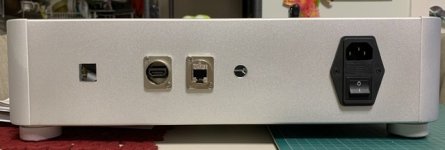 DEC3BA20-EAC8-4225-8BED-A853B8820720.jpeg42.3 KB · Views: 426
DEC3BA20-EAC8-4225-8BED-A853B8820720.jpeg42.3 KB · Views: 426 -
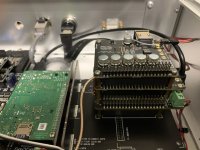 EDBA1D5E-85D2-4B5B-AC31-A31E4D9158D8.jpeg108.2 KB · Views: 450
EDBA1D5E-85D2-4B5B-AC31-A31E4D9158D8.jpeg108.2 KB · Views: 450 -
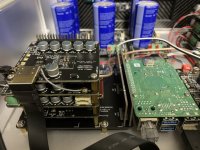 4C8E00D5-E788-4C3B-9089-7F70E2C4A8A8.jpeg124.4 KB · Views: 471
4C8E00D5-E788-4C3B-9089-7F70E2C4A8A8.jpeg124.4 KB · Views: 471 -
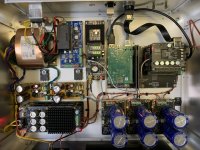 E1215B09-E192-4797-BD6D-03B98BDF0F7A.jpeg145.2 KB · Views: 458
E1215B09-E192-4797-BD6D-03B98BDF0F7A.jpeg145.2 KB · Views: 458 -
 BF1D6DEF-1460-4133-A951-684A8E8933C3.jpeg141.2 KB · Views: 489
BF1D6DEF-1460-4133-A951-684A8E8933C3.jpeg141.2 KB · Views: 489
@casshan
Very nice implement. Congratulations!
What R-2R DAC you are using? How do you like the sound quality? And what's the case?
I still haven't fixed the Class D clock. I'll give another try soon. Just want to get it compared with the TWTMC clocks.
Ian
Very nice implement. Congratulations!
What R-2R DAC you are using? How do you like the sound quality? And what's the case?
I still haven't fixed the Class D clock. I'll give another try soon. Just want to get it compared with the TWTMC clocks.
Ian
@dddac
For me, RaspberryPi Zero/W sounds obviously better. With FifoPi installed in the system, it doesn't change the whole sound style. The only differences is the clarity. RPi Zero/w with wifi connection plays music more clear then RPi Zero with USB Ethernet connection.
Regards,
Ian
I once told you that if any wire contains GND, it will transmit noise. This is why MSB recommends that users change to I2S wire without GND. When it is unavoidable to use wires containing GND, only the ground box can absorb the GND noise from GND. The grounding box mainly contains natural ore, Obsidian, so that the grounding box has the ability to absorb GND noise permanently, which is like a permanent magnet with permanent magnetism. These extremely subtle and unmeasurable GND noises close to natural ore will cause extremely fine vibrations of the ore, so that the GND noise will be converted into extremely fine heat energy and be consumed, achieving the effect of absorbing GND noise.
I am a person who specializes in researching and manufacturing grounding boxes for 10 years. It's a pity that most people don't believe in grounding boxes, but they can't explain the effect of avoiding the use of GND wires.
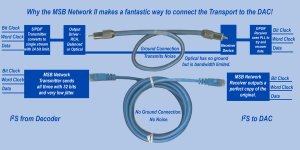
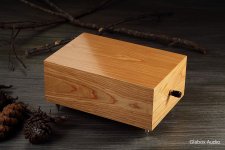
Thanks Ian 🙂@casshan
Very nice implement. Congratulations!
What R-2R DAC you are using? How do you like the sound quality? And what's the case?
I still haven't fixed the Class D clock. I'll give another try soon. Just want to get it compared with the TWTMC clocks.
Ian
The red PCB board is R2R DAC from China, it claims it accept PCM 384K and DSD 512 but I always hear some high frequency noise when I play music with HQP + Roon, very annoying... Eventually I decided to make the player to become a pure transporter so I bought some components from you before. I am using Holo Spring 2 DAC with I2S input. The sound is very very good, as Stereophile said: it may be the end-game of DAC, and all music sound non-digital. The DAC is borrowed from my friend. I may buy the latest Holo MAY DAC which is the current flagship DAC of Holo audio, sound is no doubt very good too.
Trying to get the most out of TWTMC clocks for FifoPi system (2)
First impression
After breaking-in for more than two days, I started listening to the TWTMC DIRXO 22.5792MHz in my listening room.
The setup was here:
https://www.diyaudio.com/forums/dig...mate-weapon-fight-jitter-657.html#post6668751
The first impression was very promising. I have to say it’s a really good clock for audiophiles. Thanks Andrea for your great jobs!
1. Very musical, could be the best I had ever experienced for this point
2. The sound image was very sold with high density
3. A lot of more details
4. Very sweet and comfortable sound
5. Music was very stable and flawless
6. Feels the sound volume was a little bit higher than CCHD957 under same condition
However, comparing with my other setup (FifoPi Q3+ReClockPi+Pulsar 90/98 +ES9038Q2M DM +OPA861 balanced I/V, LifePO4/UltraCapacitor power supplies), I felt:
1. The 3D image is not as focused as I thought
2. The sound stage was wide but not very deep. Feels a little bit flat and closed.
3. The sound images of each instrument are a bit bigger than they should be.
4. A little bit less dynamic, not as vivid as live
I don’t think this comparison is very fair, because
a. The clock frequencies were different
b. The DACs were different, one is normal commercial DAC (D90) and the other is very well built audiophile DIY DAC.
So, I replaced TWTMC DIRXO with a CCHD957 22.5792MHz under the same setup. But my ears told me I still can not say TWTMC DIRXO is superior to CCHD947 over the above items.
According to Andrea’s phase noise measurement results, TWTMC DIRXO should be better overall. So, I will do more tests to figure out how to get the best out of TWTMC clocks.
Ian
First impression
After breaking-in for more than two days, I started listening to the TWTMC DIRXO 22.5792MHz in my listening room.
The setup was here:
https://www.diyaudio.com/forums/dig...mate-weapon-fight-jitter-657.html#post6668751
The first impression was very promising. I have to say it’s a really good clock for audiophiles. Thanks Andrea for your great jobs!
1. Very musical, could be the best I had ever experienced for this point
2. The sound image was very sold with high density
3. A lot of more details
4. Very sweet and comfortable sound
5. Music was very stable and flawless
6. Feels the sound volume was a little bit higher than CCHD957 under same condition
However, comparing with my other setup (FifoPi Q3+ReClockPi+Pulsar 90/98 +ES9038Q2M DM +OPA861 balanced I/V, LifePO4/UltraCapacitor power supplies), I felt:
1. The 3D image is not as focused as I thought
2. The sound stage was wide but not very deep. Feels a little bit flat and closed.
3. The sound images of each instrument are a bit bigger than they should be.
4. A little bit less dynamic, not as vivid as live
I don’t think this comparison is very fair, because
a. The clock frequencies were different
b. The DACs were different, one is normal commercial DAC (D90) and the other is very well built audiophile DIY DAC.
So, I replaced TWTMC DIRXO with a CCHD957 22.5792MHz under the same setup. But my ears told me I still can not say TWTMC DIRXO is superior to CCHD947 over the above items.
According to Andrea’s phase noise measurement results, TWTMC DIRXO should be better overall. So, I will do more tests to figure out how to get the best out of TWTMC clocks.
Ian
Attachments
Ian,
May I ask if you also have a good reference level headphone setup (headphones and HPA)? If so, do you also use that for doing listening comparisons?
IME sometimes that is necessary for chasing down the source of some problems by ear.
May I ask if you also have a good reference level headphone setup (headphones and HPA)? If so, do you also use that for doing listening comparisons?
IME sometimes that is necessary for chasing down the source of some problems by ear.
Hello,
Unless you know the sound '' preferences '', the gear and the room of the '' reviewing '' person you should use the information give more like a kind of guidance to what to expect if you make a similar change in your system.
AND it could well be that if you would use Ian's systems to find out where to go( because your are living in the same hood), copy the complete digital daisy chain to connected to your headphone only set using a single ended 2A3 Will it be perfect?
Of course Ian's set has a big reflecting screen between his loudspeakers and it looks like he needs powerful amps. A direct coupled 2A3 amp will have two tubes , a few resistors, some iron, some caps much easier to create a nice sound i think.
Greetings, Eduard
P.s the UFL output can be used instead of the SMA because the cable is just a short one?
Unless you know the sound '' preferences '', the gear and the room of the '' reviewing '' person you should use the information give more like a kind of guidance to what to expect if you make a similar change in your system.
AND it could well be that if you would use Ian's systems to find out where to go( because your are living in the same hood), copy the complete digital daisy chain to connected to your headphone only set using a single ended 2A3 Will it be perfect?
Of course Ian's set has a big reflecting screen between his loudspeakers and it looks like he needs powerful amps. A direct coupled 2A3 amp will have two tubes , a few resistors, some iron, some caps much easier to create a nice sound i think.
Greetings, Eduard
P.s the UFL output can be used instead of the SMA because the cable is just a short one?
Nice shot of the listening room. This is a system that will reveal details. 🙂First impression
....
According to Andrea’s phase noise measurement results, TWTMC DIRXO should be better overall. So, I will do more tests to figure out how to get the best out of TWTMC clocks.
Ian
The comparison is kind of like saying these Michelin tires on this 911 do not turn in as well as these Pirellis on the Maclaren. But the Michelins really smooth out the bumps. Did we just compare tires or cars or both.
I'd be interested in hearing your impression when only the clock changes. Can you just pull the Pulsar and insert TWTMC? And no, I think the subtle differences are easier to hear in a listening room with good speakers like you have than on headphones. The depth and placement of image and ambient clues on live performances seem more obvious on speakers in room IMHO.
Last edited:
Hmmm. I use Sound Lab electrostats for speakers, 645 frame size. Use Audeze LCD-X for cans. For soundstage, speakers are better. For a microscope on the sound, probably Stax electrostat headphones are the best.
SC-Cut crystals should be very good. As well as the very well designed TWTMC DIRXO.
I highly suspect the sine to square converter board. I'll post some measurement results to confirm.
Ian
I highly suspect the sine to square converter board. I'll post some measurement results to confirm.
Ian
First impression
After breaking-in for more than two days, I started listening to the TWTMC DIRXO 22.5792MHz in my listening room.
Thank you so much for this, it's really beneficial no matter the outcome. Glad the Pulsar clock could hold it's own and then some during the 1st sweep of impressions. Still TBD, but having a Pulsar clock for portable use would be a dream.
I'm not sure if this could be adjusted or if it even relates to the volume issue:6. Feels the sound volume was a little bit higher than CCHD957 under same condition
Ian
Output: 50 Ohm square wave (+15 dBm)
Last edited:
- Home
- Source & Line
- Digital Line Level
- Asynchronous I2S FIFO project, an ultimate weapon to fight the jitter
